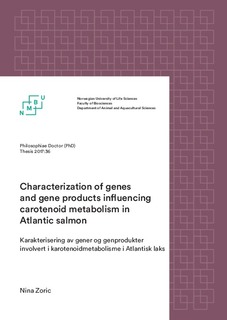| dc.description.abstract | Distinct red flesh color is a unique trait of the fish genera Oncorhynchus, Salvelinus, Salmo and Parahucho. In this thesis we have investigated its molecular basis in Atlantic salmon to better understand how and why it developed during the evolution in just these genera. In the aquaculture industry, the red muscle color in salmon is important for consumers perception of filet quality. The red flesh color is mainly caused by accumulation of the carotenoid astaxanthin in muscle tissue, obtained through a crustean rich diet in the wild, or by feed supplementation of syntetic astaxanthin in aquaculture.
Individual differences in salmon flesh color intensity in groups fed identical amounts of pigment, indicate variable uptake and metabolic processing between individuals. In order to improve or standardise the flesh coloration, genetic factors and molecular mechanisms responsible for the variation must be identified. Previous studies recognized that low absorption and/or high metabolic transformation rate are critical factors for the observed low retention of astaxanthin in muscle. Previous genome wide association studies have strongly indicated that the β-carotene oxygenases bco1 and bco1l are involved in the flesh coloration. The aim of this thesis was to further investigate how bco1 and its paralogue bco1l influence astaxanthin metabolism and to discover additional genes that might contribute to the flesh color variation.
In paper I, the fast freeze substitution tissue preservation method was developed as a useful tool for the experiments performed in paper II and paper III. The main advantage of this preservation method over the standardly used formalin fixation is that fixed tissues are suitable for more than only one type of analysis. Tissue morphology, RNA and proteins are very well preserved with freeze fixation and samples can be used for microscopy, but also for highly sensitive downstream analysis like RNA sequencing and protein and immunoblotting analysis.
In paper II, the functional roles of bco1 and bco1l in carotenoid metabolism were investigated using molecular cloning and gene expression methods, western blotting and confocal microscopy. By immunostaining methods, we showed that Bco1 is a cytosolic enzyme primarily located in the subapical regions of enterocytes. These analyses also revealed that Bco1 is two folds more abundant in intestine of pale compared to red-fleshed fish. We did not manage to develop Bco1l specific antibodies, which explains the lack of corresponding analyses for Bco1l. By co-expressing either of the two genes with a β-carotene synthesizing cassette in E. coli, Bco1l showed a clear 15,15’-oxygenase activity on β-carotene, while Bco1 did not show any cleavage activity in this particular assay. Based on these experiments, we hypotheised that Bco1 is involved in astaxanthin degradation, while Bco1l degrades other carotenoids. RNA sequencing and gene set enrichment analysis (GSEA) showed that lipid-metabolism related genes, indicating that accumulation of astaxanthin in salmon is related to lipid metabolism.
In paper III a region on chromosome 2 containing SNPs strongly associated with salmon flesh coloration were identified by genome wide association mapping. Fine mapping of this region suggested that ATP binding cassette subfamily G member 2 (abcg2-1a) is another QTL for flesh color. A missense mutation in abcg2-1a, causing an amino acid substitution in amino acid position 230 (Asn230Ser), is proposed to be a causative mutation. Abcg2 is a known exporter of lipophilic molecules, and we suggest that Abcg2-1a is involved in salmon flesh coloration by translocating astaxanthin from enterocytes to the intestinal lumen, thus limiting the astaxanthin availability for muscle deposition. The Abcg2-1a protein was 2.5 folds more abundant in the pale-fleshed fish than in red-fleshed fish, supporting that this exporter plays a role in the flesh pigmentation. | nb_NO |

